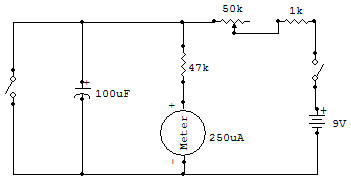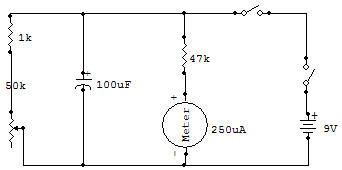 |
 |
| A | B |
Resistors and capacitors together
 |
 |
| A | B |
We've explored what resistors and capacitors can do separately. But in most circuits we use them together, and some interesting things result when we do.
When you finish the wiring connections of circuit A, put the power ON. You'll notice that the Meter pointer goes all the way over to the right.
Press the Key, and the Meter pointer returns to 0. Now release the Key, and you'll notice the Meter pointer returns to the right at a certain speed.
Now press the Key again, but this time try moving the Control Knob when you release it. What happens to the Meter pointer?
The speed at which the Meter pointer moves toward the right changes as you adjust the Control. Can you guess why this happens? (Hint: remember what a resistor does in a circuit).
The Control determines how fast the capacitor charges. When the Control is set for a low resistance , more current reaches the capacitor and it can charge faster. But when the Control is set to a high resistance, only a small amount of current reaches the capacitor and it takes a longer time to fully charge.
Now if a resistor can affect a capacitor's charging time, what else do you suppose it could affect? (Think out your answer carefully... because we're going to find out how right you are in just a few minutes.)
We're now going to find out the answer to that question. (You didn't expect us to let you off the hook, did you?).
After you complete the wiring connections of circuit B, put the power ON.
Press the Key and the Meter pointer will swing to the right.
Now release the Key and you'll see the Meter pointer return to the left toward 0 at a certain speed.
Press and release the Key again but now adjust the Control Knob after releasing the Key. You'll see the Meter pointer return at different speeds as you adjust the Control. Can you figure out what's happening?
The Control is adjusting how fast the capacitor can discharge. If the current from the capacitor meets a high resistance, the capacitor cannot discharge as quickly as it could into a low resistance. You see now that a resistor can control both the charging and discharging times of a capacitor.
Electronics engineers refer to this as the R-C Time Constant. This means we can control the operation of several circuits, such as oscillators, by using different values of resistors and capacitors. We'll see several examples of how this is done in future Projects.
